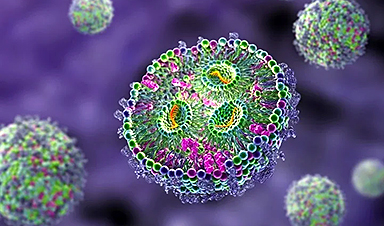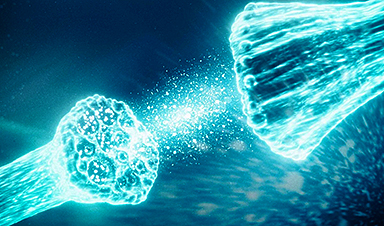Nanodiscs are synthetic phospholipid particles with a distinct morphology and size that enhance their efficiency in drug delivery applications.1 First developed by Sligar et al. in the early 2000s, these model membrane systems measure around 10 nm in diameter with a thickness between 4.6 and 5.6 nm.2 Structurally, nanodiscs are similar to high-density lipoproteins.
In medical applications, nanotechnology advancements have positioned nanodiscs as valuable tools for diagnosing and treating various diseases. These disc-shaped particles can preserve membrane proteins in their functional state outside the cellular environment, making them valuable in biomedical applications.1
Nanodiscs stabilize fragile proteins, enhance drug delivery, and provide a structured bilayer surface, proving highly effective for studying cellular signaling complexes on membrane surfaces.1 Their versatility continues to support advancements in modern medicine.
Classification of Nanodiscs
Nanodiscs can be categorized based on the stabilizer used to maintain their structure.3
Membrane Scaffold Protein Nanodiscs
Membrane scaffold protein (MSP) nanodiscs use amphipathic membrane scaffold proteins as stabilizers. These scaffold proteins encircle a stable, discoidal phospholipid bilayer containing embedded transmembrane proteins, forming the nanodisc structure.
MSP is typically a truncated form of apolipoprotein A-I (apoA-I), a component of high-density lipoproteins. It wraps around a small segment of the phospholipid bilayer to create the disc-shaped nanodisc.3
MSP provides a hydrophobic surface for lipid tails and a hydrophilic outer surface, making nanodiscs highly soluble in water. During assembly, excess detergent is used and later removed with bio-beads, allowing membrane proteins to stay in solution without detergents.
These nanodiscs are well-suited for studying membrane proteins in both prokaryotic and eukaryotic systems, including key structures like transporters, ion channels, and G protein-coupled receptors (GPCRs).4
Saposin nanodiscs
The saposin protein family consists of four members, saposin A–D, each with a molecular weight of around 10 kDa. Saposin A is most commonly used for assembling saposin nanodiscs. Frauenfeld et al. (2016) demonstrated the use of saposin proteins as scaffolds to reconstitute various membrane proteins within a phospholipid environment.5
Saposin nanodiscs self-assemble from saposin proteins, phospholipids, and membrane proteins into a stable structure that is adaptable to various membrane protein sizes without requiring scaffold construction or lipid ratio adjustments.3 Although a recent development, they are widely applied in structure-based techniques like NMR and cryo-EM, providing distinct advantages for both methods.
For example, in a solution-based NMR study, three membrane proteins were successfully incorporated into saposin nanodiscs: bacterial outer membrane protein X (OmpX), sensory receptor rhodopsin II (pSRII), and the β1-adrenergic receptor (β1AR).6
Copolymer Nanodiscs
Copolymer nanodiscs extract membrane proteins directly from cell membranes, preserving their native state and endogenous phospholipids. Synthetic polymers encapsulate the proteins into nanosized discs, stabilizing a portion of the native membrane. These nanodiscs use the cell’s natural phospholipids, with the polymer acting as both solubilizer and stabilizer, removing the need for additional detergents.3
Synthetic copolymers like styrene-maleic acid (SMA), diisobutylene maleic acid (DIBMA), and polymethacrylate (PMA) are used to stabilize nanodiscs, maintaining the lipid bilayer in aqueous solutions. These non-protein polymers self-assemble into stable structures and offer higher purity than MSP nanodiscs. They are widely used in membrane protein research, drug delivery, and biosensor applications.3
SMA nanodiscs have been successfully employed to purify and study integral membrane proteins from bacterial and eukaryotic systems. Once reconstituted into SMA nanodiscs, these proteins are well-suited for high-resolution structural analysis via cryo-EM, as well as for receptor-ligand binding assays and functional activity studies.7
Applications of Nanodiscs in Medicine
Drug Delivery
Nanodiscs offer an effective platform for enhancing drug delivery systems, particularly for drugs with low water solubility. Their lipid bilayer structure can encapsulate hydrophobic drugs, protecting them from premature degradation while enhancing their bioavailability.3
Chen et al. designed lipid nanodiscs functionalized with cyclic RGD peptide (cRGD) on either the edges or planes, creating two distinct anisotropic targeting nanocarriers (E-cRGD-NDs and P-cRGD-NDs) for siRNA delivery.8 E-cRGD-NDs demonstrated significant advantages in siRNA loading, cellular uptake, gene silencing efficiency, protein expression, and in vivo performance.
In a 2023 study, Yu et al. developed antibodies targeting matrix protein 2 (M2) of the influenza A virus. M2 (1-46) was incorporated into nanodiscs to form a membrane-embedded tetrameric structure, closely resembling its natural physiological state within the influenza virus envelope.9
Companies like Cube Biotech are actively developing nanodisc-based drug delivery systems that can be customized for different therapeutic needs. Its lipid-based nanodiscs offer a flexible platform for encapsulating and delivering various pharmaceuticals, including biologics and small-molecule drugs.
Vaccine Development
Nanodiscs have emerged as promising platforms for developing personalized tumor immunotherapy and vaccines against infectious diseases. They can be loaded with antigenic peptides or tumor markers, preserving the structure and activity of membrane proteins, which makes them highly immunogenic.1
Aldehyde dehydrogenase (ALDH) has been extensively used as a marker for isolating cancer stem cells (CSCs). These cells are characterized by high proliferation rates and play a role in tumor metastasis and recurrence.10 ALDH-positive CSCs have been identified in over 20 different tumor types.1
In a 2020 study, James J. Moon’s research group developed synthetic nanodiscs for vaccines targeting ALDHhigh CSCs. These nanodiscs improve antigen delivery to lymph nodes and trigger strong ALDH-specific T-cell responses, offering a promising new approach for cancer immunotherapy focused on CSCs.11
Diagnostic Tools
Nanodiscs offer considerable potential for creating advanced diagnostic tools. Their ability to stabilize membrane proteins in their native conformation makes them excellent tools for studying protein-protein interactions, enzymatic functions, and other cellular processes.12
NMR has long been used to gather structural information on soluble proteins. Rienstra and colleagues were the first to report solid-state NMR (ssNMR) spectra of nanodiscs, confirming that membrane scaffold proteins are organized in a “belt” configuration.13
Recently, there has been substantial growth in the use of both solution and ssNMR methods with nanodiscs, providing critical insights into the structure and function of membrane proteins. For instance, the complete three-dimensional structure of OmpX in nanodiscs, obtained through solution NMR, highlighted the ability to detect subtle conformational differences in a native bilayer environment.14
Conclusion
Nanodiscs represent a transformative innovation in medicine, with applications spanning protein stabilization, drug delivery, vaccine development, and diagnostics. Their ability to mimic natural cell membranes while remaining stable in various environments allows for broad applications in both research and clinical contexts.
Looking ahead, the future of nanodiscs in healthcare is strong. Continued research into polymer-based and MSP nanodiscs could lead to more robust and customizable platforms for therapeutic and diagnostic use.
As more companies and research institutions explore these applications, nanodiscs are likely to support more precise, effective, and personalized treatments in modern medicine.
References and Further Reading
1. Mu, Q., Deng, H., An, X., Liu, G. Liu, C. (2024). Designing nanodiscs as versatile platforms for on-demand therapy. Nanoscale. https://pubs.rsc.org/en/content/articlelanding/2024/nr/d3nr05457h
2. Nath, A., Atkins, WM. Sligar, SG. (2007). Applications of Phospholipid Bilayer Nanodiscs in the Study of Membranes and Membrane Proteins. Biochemistry. https://pubmed.ncbi.nlm.nih.gov/17263563/
3. Dong, Y., Tang, H., Dai, H., Zhao, H. Wang, J. (2024). The application of nanodiscs in membrane protein drug discovery & development and drug delivery. Front. Chem. https://pmc.ncbi.nlm.nih.gov/articles/PMC11445163/
4. Zhang, M. et al. (2021). Cryo-EM structure of an activated GPCR–G protein complex in lipid nanodiscs. Nat. Struct. Mol. Biol. https://pubmed.ncbi.nlm.nih.gov/33633398/
5. Frauenfeld, J. et al. (2016). A saposin-lipoprotein nanoparticle system for membrane proteins. Nat. Methods. https://pubmed.ncbi.nlm.nih.gov/26950744/
6. Chien, C.-T. H. et al. (2017). An adaptable phospholipid membrane mimetic system for solution NMR studies of membrane proteins. J. Am. Chem. Soc. https://pubmed.ncbi.nlm.nih.gov/28990386/
7. Swainsbury, DJK. et al. (2023). Cryo-EM structure of the four-subunit Rhodobacter sphaeroides cytochrome bc 1 complex in styrene maleic acid nanodiscs. Proc. Natl. Acad. Sci. https://www.pnas.org/doi/10.1073/pnas.2217922120
8. Chen, X., Zhou, Y., Zhao, Y. Tang, W. (2023). Targeted degradation of extracellular secreted and membrane proteins. Trends Pharmacol. Sci. https://pubmed.ncbi.nlm.nih.gov/37758536/
9. Yu, C. et al. (2023). Screening and characterization of inhibitory vNAR targeting nanodisc-assembled influenza M2 proteins. Iscience. https://pubmed.ncbi.nlm.nih.gov/36570769/
10. Marcato, P., Dean, CA., Giacomantonio, CA. Lee, PWK. (2011). Aldehyde dehydrogenase: its role as a cancer stem cell marker comes down to the specific isoform. Cell cycle. https://pubmed.ncbi.nlm.nih.gov/21552008/
11. Hassani Najafabadi, A. et al. (2020). Cancer immunotherapy via targeting cancer stem cells using vaccine nanodiscs. Nano Lett. https://pmc.ncbi.nlm.nih.gov/articles/PMC7572838/
12. Denisov, IG. Sligar, SG. (2017). Nanodiscs in membrane biochemistry and biophysics. Chem. Rev. https://pubmed.ncbi.nlm.nih.gov/28177242/
13. Li, Y., Kijac, AZ., Sligar, SG., Rienstra, CM. (2006). Structural analysis of nanoscale self-assembled discoidal lipid bilayers by solid-state NMR spectroscopy. Biophys. J. https://pubmed.ncbi.nlm.nih.gov/16905610/
14. Hagn, F., Wagner, G. (2015). Structure refinement and membrane positioning of selectively labeled OmpX in phospholipid nanodiscs. J. Biomol. NMR. https://pubmed.ncbi.nlm.nih.gov/25430058/
News
Scientists Unlock a New Way to Hear the Brain’s Hidden Language
Scientists can finally hear the brain’s quietest messages—unlocking the hidden code behind how neurons think, decide, and remember. Scientists have created a new protein that can capture the incoming chemical signals received by brain [...]
Does being infected or vaccinated first influence COVID-19 immunity?
A new study analyzing the immune response to COVID-19 in a Catalan cohort of health workers sheds light on an important question: does it matter whether a person was first infected or first vaccinated? [...]
We May Never Know if AI Is Conscious, Says Cambridge Philosopher
As claims about conscious AI grow louder, a Cambridge philosopher argues that we lack the evidence to know whether machines can truly be conscious, let alone morally significant. A philosopher at the University of [...]
AI Helped Scientists Stop a Virus With One Tiny Change
Using AI, researchers identified one tiny molecular interaction that viruses need to infect cells. Disrupting it stopped the virus before infection could begin. Washington State University scientists have uncovered a method to interfere with a key [...]
Deadly Hospital Fungus May Finally Have a Weakness
A deadly, drug-resistant hospital fungus may finally have a weakness—and scientists think they’ve found it. Researchers have identified a genetic process that could open the door to new treatments for a dangerous fungal infection [...]
Fever-Proof Bird Flu Variant Could Fuel the Next Pandemic
Bird flu viruses present a significant risk to humans because they can continue replicating at temperatures higher than a typical fever. Fever is one of the body’s main tools for slowing or stopping viral [...]
What could the future of nanoscience look like?
Society has a lot to thank for nanoscience. From improved health monitoring to reducing the size of electronics, scientists’ ability to delve deeper and better understand chemistry at the nanoscale has opened up numerous [...]
Scientists Melt Cancer’s Hidden “Power Hubs” and Stop Tumor Growth
Researchers discovered that in a rare kidney cancer, RNA builds droplet-like hubs that act as growth control centers inside tumor cells. By engineering a molecular switch to dissolve these hubs, they were able to halt cancer [...]
Platelet-inspired nanoparticles could improve treatment of inflammatory diseases
Scientists have developed platelet-inspired nanoparticles that deliver anti-inflammatory drugs directly to brain-computer interface implants, doubling their effectiveness. Scientists have found a way to improve the performance of brain-computer interface (BCI) electrodes by delivering anti-inflammatory drugs directly [...]
After 150 years, a new chapter in cancer therapy is finally beginning
For decades, researchers have been looking for ways to destroy cancer cells in a targeted manner without further weakening the body. But for many patients whose immune system is severely impaired by chemotherapy or radiation, [...]
Older chemical libraries show promise for fighting resistant strains of COVID-19 virus
SARS‑CoV‑2, the virus that causes COVID-19, continues to mutate, with some newer strains becoming less responsive to current antiviral treatments like Paxlovid. Now, University of California San Diego scientists and an international team of [...]
Lower doses of immunotherapy for skin cancer give better results, study suggests
According to a new study, lower doses of approved immunotherapy for malignant melanoma can give better results against tumors, while reducing side effects. This is reported by researchers at Karolinska Institutet in the Journal of the National [...]
Researchers highlight five pathways through which microplastics can harm the brain
Microplastics could be fueling neurodegenerative diseases like Alzheimer's and Parkinson's, with a new study highlighting five ways microplastics can trigger inflammation and damage in the brain. More than 57 million people live with dementia, [...]
Tiny Metal Nanodots Obliterate Cancer Cells While Largely Sparing Healthy Tissue
Scientists have developed tiny metal-oxide particles that push cancer cells past their stress limits while sparing healthy tissue. An international team led by RMIT University has developed tiny particles called nanodots, crafted from a metallic compound, [...]
Gold Nanoclusters Could Supercharge Quantum Computers
Researchers found that gold “super atoms” can behave like the atoms in top-tier quantum systems—only far easier to scale. These tiny clusters can be customized at the molecular level, offering a powerful, tunable foundation [...]
A single shot of HPV vaccine may be enough to fight cervical cancer, study finds
WASHINGTON -- A single HPV vaccination appears just as effective as two doses at preventing the viral infection that causes cervical cancer, researchers reported Wednesday. HPV, or human papillomavirus, is very common and spread [...]





















